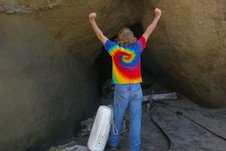Holes In Pescadero, Part1
 Story by John Vonderlin
Story by John Vonderlin
Email John ([email protected])
Holes in Pescadero, Part I
Hi June,
Hi June,
Just as with many of my previous postings, the next two will deal with holes in Pescadero. One hole had a minor historical significance and still exists. The other was never created, and if created would have been filled as fast as possible anyway. Oddly, the longterm utility of the first may have led to the never-realized dream of creating the second one.
The first hole was brought to my attention, once again, by Dr. Alan Brown’s 1960 book, “Place Names in San Mateo County,” [published by, and available at the San Mateo County History Museum in Redwood City.]
While reading through Place Names, I discovered a couple of entries that piqued my interest.
The first was for “The Stage Hole,” and simply said:
“The Stage Hole (The pond at Nunziati’s dam in Pescadero beyond the end of Water Lane). At some distant date a stagecoach upset into the water here (Alec Moore) The wagon and stage road ran past here in the middle and late 1850’s”
That was followed by another entry for “The Stage Road,” that stated in part: “…it has been so called in Pescadero ever since it was built in 1859, by the leading citizens of that place, for the Pescadero-Spanishtown Stage Company.”
I’d only been down Water Lane once, to visit the eastern edge of the Pescadero Marsh Preserve, so it seemed like a return visit was in order. I’d been checking out possible kayaking routes deeper into the Preserve than our forays up Pescadero Creek from the oceanside lagoon had permitted. The highlights of that first trip were the views from the top of Round Hill and the minor mystery of a large circular enclosure made of plywood at its base. Having done some bushwhacking to get to it, we were initially mystified why somebody would build such an expensive fence in the middle of nowhere.
As we made our way around its perimeter, the small holes cut in the plywood at regular intervals, with wire cones in them, strongly hinted at what we were seeing. But, the full details and purpose of this project were only revealed by an Internet search that brought up this government website:
Round Hill Levee Removal IS/MND. Pescadero State Beach … levee near Round Hill separates Pescadero Creek from its floodplain, thus preventing …
parks.ca.gov/pages/980/files/6228 draft is-mnd round hill levee removal pescadero…
The purpose of the enclosure was to keep San Francisco Garter Snakes or Red-Legged Frogs from entering the enclosed area and allow any in there a one way method of egress, before the levee removal project was attempted. I hope those critters, assuming there were actually any there, appreciate the trouble somebody went to in order to protect them.
But back to my trip to “The Stage Hole,” in Pescadero. Water Lane runs north off of Pescadero Road about a half mile east of downtown Pescadero. Near its end you’ll pass this sign and deadend at the Ranger Station.

Park there and head up the dirt road to the right. With a gentle slope and a hairpin turn it brings you to the top of a hummock behind the Ranger Station. On top of the hummock the road takes a hard right.
.. To your left is “The Stage Hole,” separated from the canyon that slopes steeply away to the right by the previously-mentioned road-topped Nunziati earthen dam, over which the stage road must have run. It is quite possible that on this turn, a hundred and fifty years ago, a stage pulled by a fresh team of horses, just harnessed up in Pescadero, urged up their first hill by the explosive crack of a whip, overshot, and tumbled into the water. “The Stage Hole,” is dry now, but it must be seasonally full, as there is a healthy clump of cattails covering much of its dry bottom.
Hiking around a bit, it became obvious that there had been a series of interconnected ponds here at one time, My guess is they provided gravity fed water to some of the crops that were grown in the rich soil of the marsh’s flatlands just to the west.. On the edge and descending into one of the ponds there is a series of stones arranged like steps. Given the pipe rising a few inches from out of the ground between the large, cemented-in-place boulders at the top of this “stairway,” the purpose apparently was to prevent erosion as the water was pumped in.
Possibly there are the remnants of a hundred and fifty year old windmill somewhere in the marsh below. It would have harvested the frequent Westerlies coming off the ocean to fill their system. Remnants of power poles indicate an electric pump accomplished the same purpose at a later time. In its time it was a near perfect system to wrestle a decent life out of the natural resources of the coastside. I think this pleasant little place may have been the inspiration for a proposal to build an extremely large hole elsewhere nearly 40 years ago. But, that’s for Part 2 of ” Holes in Pescadero?” Enjoy. John
P.S. I’ve attached an excerpt from an old U.S.G.S. topo map with a blue square about where I believe “The Stage Hole,” is located. Note the dark lines, denoting old dirt roads, that proceed across Pescadero Creek, heading both for the coast and back towards town. One of these was quite possibly the route northward for the stage until it was changed to the Stage Road route in 1859. Maybe somebody local knows.
I’ve also attached a part of a California Coastal Records Project picture from 1987 showing the area, with “Round Hill” and “The Stage Hole” marked. You can see the outline of some of the fields that were abandoned by then.









